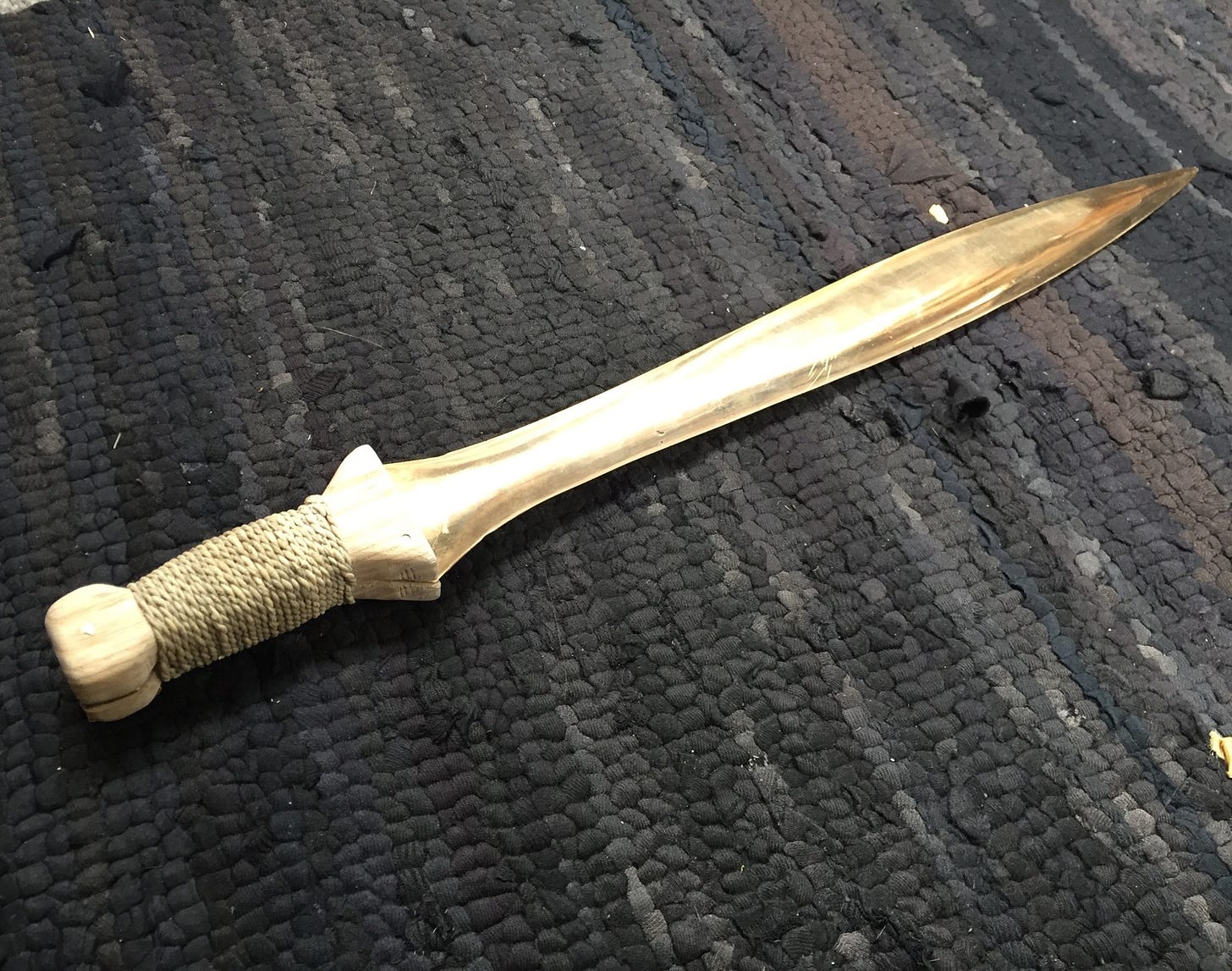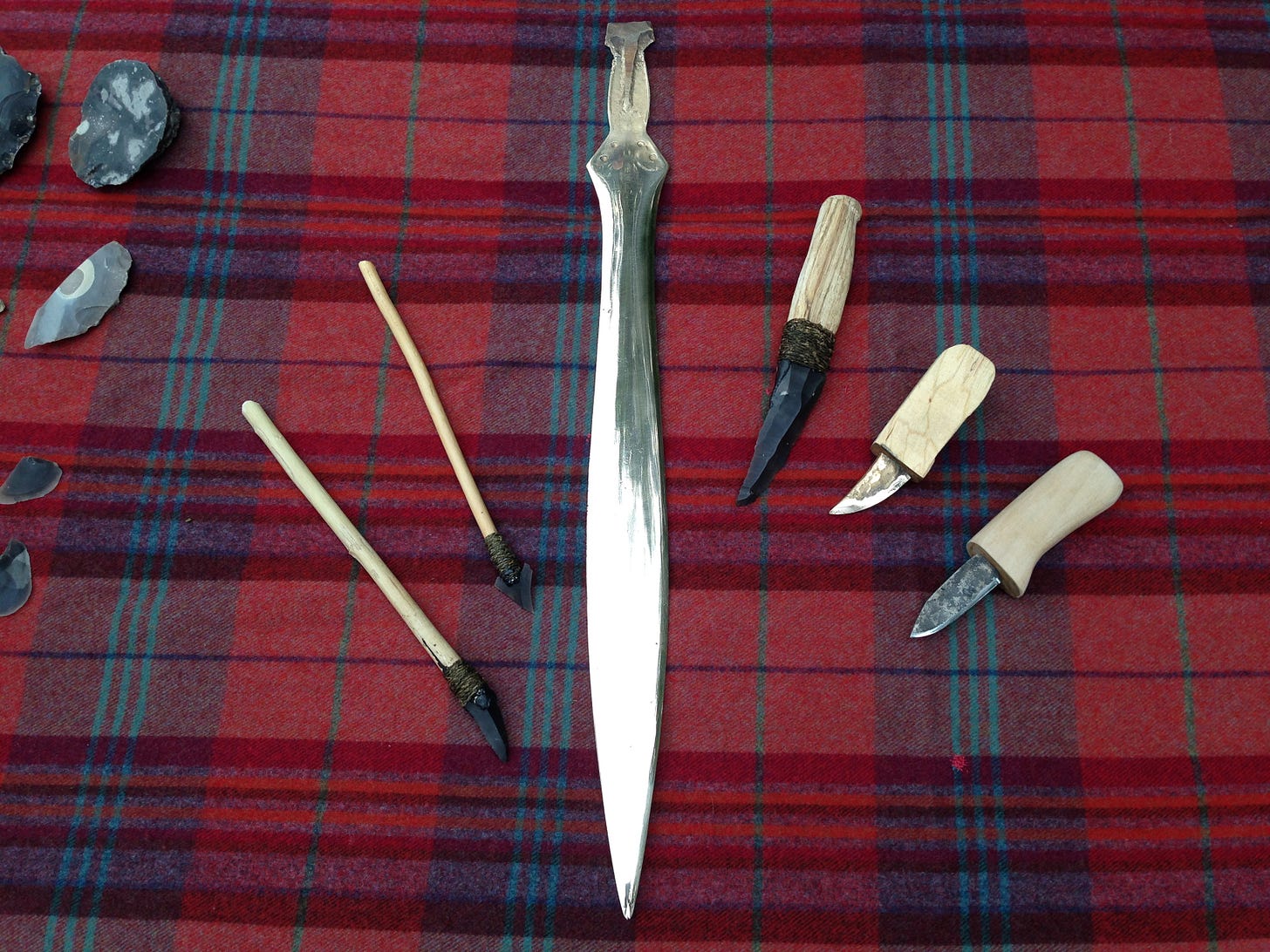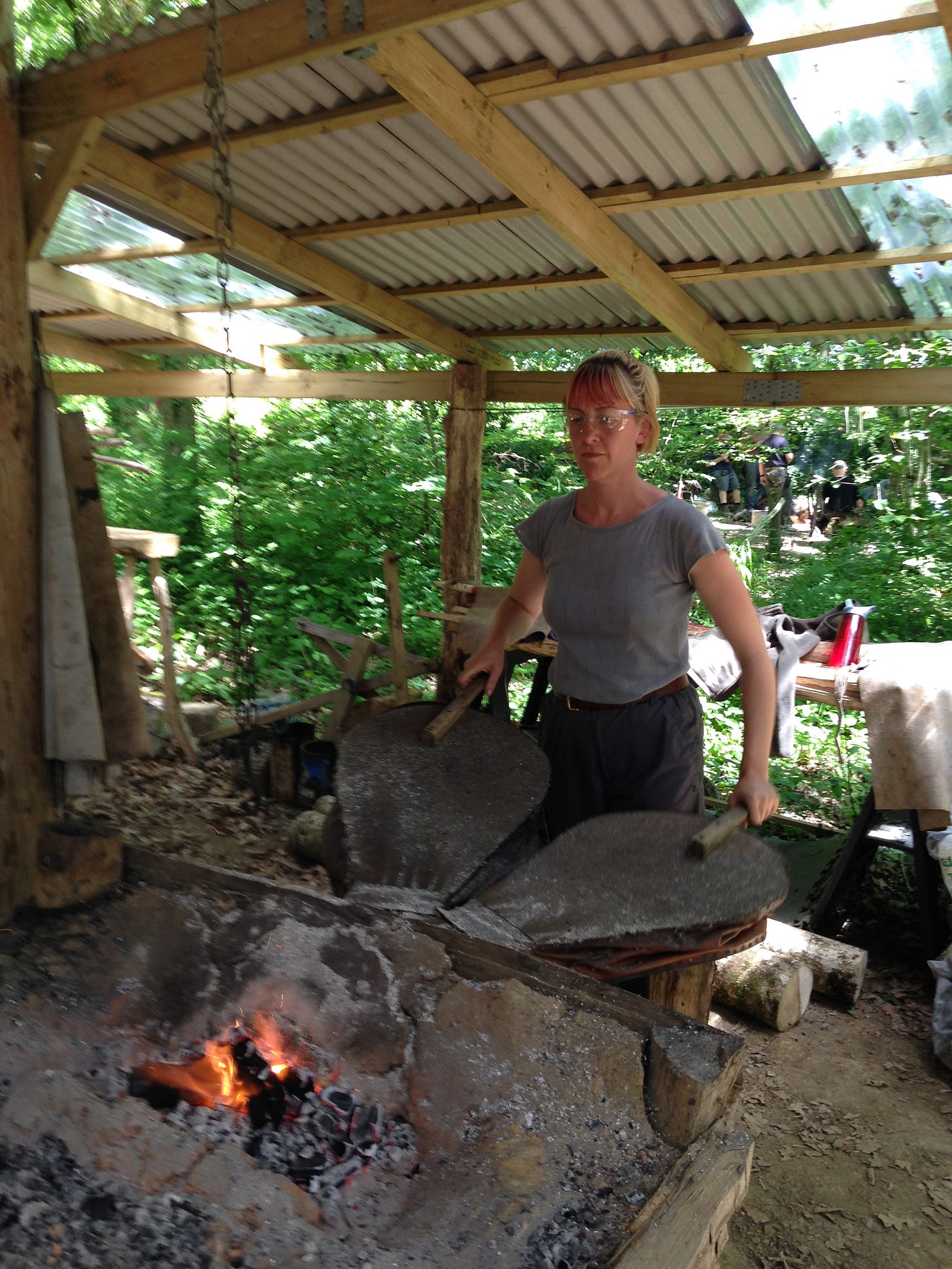Today I want to write about tempering.
Years ago I went to make a knife with the skilful Devon blacksmith and experimental archaeologist Dave Budd. Two days working flint with renowned knapper Anthony Whitlock had felt approachable to my hands as it required only short, momentary percussion and careful intent to make a serviceable blade.1
Audio version
Working with fire and steel was another matter. I found the noise and heat a real challenge, but hardest of all was hammering the hot metal into shape. Despite all the years of working with my body and although possessing enough strength, timidity gripped me, so that at first I barely tapped the glowing steel, and risked making a knife unfit for use. Finally, with loud verbal encouragement from classmates in the forge, I managed to give it some welly, make a good shaped small blade and readied it for tempering and quenching. Heating, hammering and cooling the metal in a precise order is what gives the metal its temper and allows it to eventually hold an edge.
Without being made red hot, shaped by the hammer, then plunged into tallow and water, and finally being allowed to rest and cool undisturbed, forged steel can be brittle and may shatter. Conversely, it can lose its temper, and not be able to hold a sharp edge at all, or deform and be easily bent out of shape. That all these terms are still current in how we speak of ourselves, our moods and our interactions, is testament to how closely the tempering of the psyche can feel to the process of transformation of formless metal to invaluable knife. The knife doesn’t ‘like’ being heated and beaten!2 When it is being quenched or rested, it cannot be put to use. The stages in the process are not alike, none can be missed, and most must be repeated many times…
There was a precious opportunity here to untether life’s inevitable unsatisfactoriness, pain or difficulty from suffering. By mindfully courting difficulty and letting go of my own lifelong conditioning towards constant ease or pleasure, (which is the most effective tool of enslavement ever created), I stepped for the first time into relative freedom. (I say ‘relative’, as the similarly deep conditioning I had absorbed to be pleasing, pliant and ‘not any trouble’ as a woman, took me far longer to examine and dismantle. Menopausal hormones helped greatly with this essential task, which is correct method, as rage is one of the pillars of the gates of the rite of passage into female elderhood.)
Before I learned T'ai Chi sabre and sword, though I considered myself ‘alternative’, I was actually a typical young British woman, conflict-averse, scared of many things and secretly fearful of physical attacks. In the street, men’s unsolicited comments and the casually brutal body-checks of teenage boys, venting frustration after a long school day, upset and unsettled me. Inside I was quietly furious but I had no idea how to channel this or prevent the daily indignities of urban life as a woman in the early 2000s. Life on stage at the front of a band didn’t help either: put downs to heckles are easy from the safety of a stage full of bandmates, but on the street had led to assault and harassment.
One’s own bodily autonomy, freedom of association and thought are worth fighting for, as are a host of causes claimed by our consciences. But in those days I mainly fought myself. The answer for me was not specifically to learn ‘self-defence’. It was my idea of a self that needed defence which I had to question.

I could write about my training, both weapons and empty hand, as well as the internal meditative aspect of the work. However, it is better to describe just one simple thing. It is being pushed that causes the meditation in T’ai Chi to be real. If I cannot 'stand my ground using softness' when I am attacked, then what was my meditation for? I like the Taoist term 'armchair art' for the kind of learning that doesn’t stand up to real life. T'ai Chi folk sometimes disparage seemingly serene yoga people on their yoga-mat islands, wondering if their calmness would survive being pushed over, as ours must. But joking aside, how I ever became an adult had a lot to do with doing what I didn't want to, over and over, in a vertical master-student system, for decades, eating bitter.
Many T’ai Chi teaching friends say no one younger than 35 will come to classes anymore. Moving slowly around a room and doing inscrutable partner work with classmates won't make anyone look great, get hard abs, or sound clever in the telling. It will not polish the ego, and properly taught, it will at some point dismantle the sense of ‘self’ entirely and allow you to simultaneously diminish its importance yet enlarge its scope of care. Will our art wither away as we practitioners age? Schools which import the technical approach of other martials art, with a belt system and gradings, are beginning to be more common. The machine inexorably attempts to claim all parishes and incorporate them into the horizonless conurbation of technology. I feel lucky that I was able to teach for 18 years with amazing students aged 30-75, some of whom stayed all that time. It was a privilege to do hard, elaborate practice, to hone ourselves. We are all changed, fundamentally transformed.
Recently, a friend asked me to teach him some T’ai Chi sword and sabre applications and sparring. A competitive fencer as a young man, and much younger and stronger than me, this will present an interesting challenge. My teacher was a fencer too, to the same level. It will be good to see if my body can do what it needs, now that osteo arthritis has resurfaced my hip sockets to the texture of dry bread crusts after a crow has been at them. Will my mind find the spaces in his awareness to make up for my lack of agility? We will see how I have softened (or not) over the three years since my hip injury manifested. More importantly, I have been rethinking what it is that weapons study did to me, and a friend’s email about being a pikeman as a re-enactor in his youth brought it back to mind. All my physical weapons were lost in a studio fire in 2021, so I have recently borrowed wooden swords from colleagues, and even been given a half-decent western military dress sabre which was being thrown out. To be asked to pick up arms again is a challenge, but timely.
There is a famous phrase in the T’ai Chi Classics that gets translated something like: ‘At first you must give up self to follow the other; later you may do as you wish.’ But another sense of that second phrase is ‘later you can follow your heart’s desire’. Here, the heart we are speaking of is the heart-mind (hsin or xin), not the will or the ego, not even the romantic idea of the heart-in-love; but the tempered, connected, outreaching mind of the heart. I sometimes put it this way: not getting our own way sucks at first. But later, the juicy, sparkling, elderhood that this bitter mash can ferment is how we'll one day distil pure spirit.
The 'real' quality that the 'false' practice3 of T'ai Chi weapons cultivated in me was Spirit (Shen). Until I picked up a weapon, I had no fighting spirit, only ambition. If I ever seemed fierce it was false yang, only lashing out, not the wise use of skill or power. I was scared of letting go, terrified of sacrifice, and I hoarded pleasure. Don't get me wrong, I still like pleasure, but it comes and goes like the weather and that's entirely natural.
There is plenty I do not like about aspects of the hierarchies which exist, world over, including in traditional systems of learning such as my own. Where it is correct to do so, I will continue to thoughtfully challenge or change them, as best I can, according to my conscience. However, the 'vertical' parts of cultures are as diverse as cultures themselves. That what has come before should educate and inform that which comes after, is of prime importance. If we have no elders, however flawed, to trust and learn from, we have no roots. I am doing my best to become a good elder, before I become an ancestor, and I do that through continuing to learn and practice, by sharing practical knowledge and by writing.
Working with resistant materials (wood, stone, metal, for instance) can be a complete education of the mind and body. My traditional girl’s Grammar school had no such provision, and so late in life I came to try to carve wood, knap flint, smelt copper and forge steel. My inclination is toward fibre crafts, sewing, tanning, preserving, cooking, drawing, colour-making, and all the myriad skills associated with so-called non-resistant materials. I became this way because my education was imbalanced, I doubt it was a natural inheritance. Had I been introduced early to the lathe and chisel, I know my hands would also treat these tools as familiar friends. Watching my brother’s ease with woodworking hand tools mirrors my dexterity with the needle and thread, which I had learned to use at my mother’s side as she sewed our clothes. Every time I pick up metal or wood, whether to wield a sword or to make an object, however inexpertly, I challenge the default setting of timidity inside me. I am not disparaging my fibre and leather crafts, but I know how much resistance has to teach me, and how I need to work on not fearing the push back both from hard materials, and from certain people.
Yet the most resistant material I have ever worked with is the self. It presents as impermeable, shiny, contained and particular, but on further investigation is found to be porous, changeable, amorphous and enmeshed. Pushing too hard at the start made the self shrink into something like a hard metallic ball: heavy, dull and repellent. Only through alternating soft enquiry, gentle probing, hard periods of intense work followed by real rest, did I get around the many defences of my self’s well-earned, but no longer needed, protection. The parallels with tempering, when I finally got my hands on the tongs and bellows of a forge, were plain to see. The Taoist Classics’ many allusions to this process were suddenly not picturesque archaic phrases but instead became practical advice. Between the hand-work I have been intuitively drawn to, and the ongoing inner work of my Taoist and T’ai Chi tradition, a method of sorts has now accrued. And at last, finding a sangha of dear friends and the ‘Dark Mountain diaspora’, I can also periodically quench myself and rest on the smithy shelf amongst the familiar shapes of my friends’ and colleagues’ blades, also awaiting their final cutting edge.
Below is an extract from one of my Grandmaster John Kells’ many hundreds of writings, to which I have returned after a decade. This piece profoundly affected me when I first read it in 2004 and resonates with what I have written above. If you would like to read it all, I have posted the whole piece here: The Fighting Eye of Life is Death.
[...] For want of a better word, this powerful beginning of the natural process is called yielding - the start of enheartening: filling the deprived heart of the fearful one with connexion driving away self, sorrow & thoughts.
Finding a method here is useful because then with this method you can give others your insight into freedom from fear & into connexion.
So the essence of the warrior is to never forget the technique that brought him through death & the overweening useless fear of it, & into life.
One who has not made this journey will inevitably talk of suffering.
But the fighting eye of life is death, & one experience to the warrior is no more or less important than any other, & therefore will not be indulged. [...
This week’s good things:
Dougald Hine will be touring Europe and speaking about his new book ‘At Work In the Ruins’ and I’ll be joining him, Dougie Strang, Alastair McIntosh and others in discussion in Glasgow, Scotland on 11th February 2023. Tickets are by donation and you can join us by clicking here.
The word ‘confelicity’, the experience of joy in other people’s good fortune, is something I often feel about my loved ones but until this week had never had a word for! This, and so many beautiful facts, documents, illuminations, links and exquisite calligraphy can be found in this month’s newsletter from acclaimed calligrapher and illuminator Patricia Lovett MBE. Her monthly email is full of beauty, history, great art, heritage crafts and so much erudition. You can subscribe here. Nothing else like it ever appears in my inbox. It is a mini antidote to everyday ills.
I wrote about making three blades of flint, bronze and iron in Dark Mountain 16 in 2019. You can obtain the pdf here.
Neither does the T’ai Chi student, nor the ego…
For an earlier post on using the false to cultivate the real click here.









Thank you for writing this in a new year. Your words give breathing space around what is so difficult in being female in this present culture.
I really enjoyed this piece Caroline, especially these statements, That what has come before should educate and inform that which comes after, is of prime importance. If we have no elders, however flawed, to trust and learn from, we have no roots. I am doing my best to become a good elder, before I become an ancestor, and I do that through continuing to learn and practice, by sharing practical knowledge and by writing." I am fully immersed in my ancestry right now and have learned so very much about those who've come before me. I am fortunate to still have my mother to talk with about my ancestors and - as you said - I strive to share as much of my gained knowledge as possible.
Also...thank you for including the audio version of your essay, it was a pleasure to listen to.